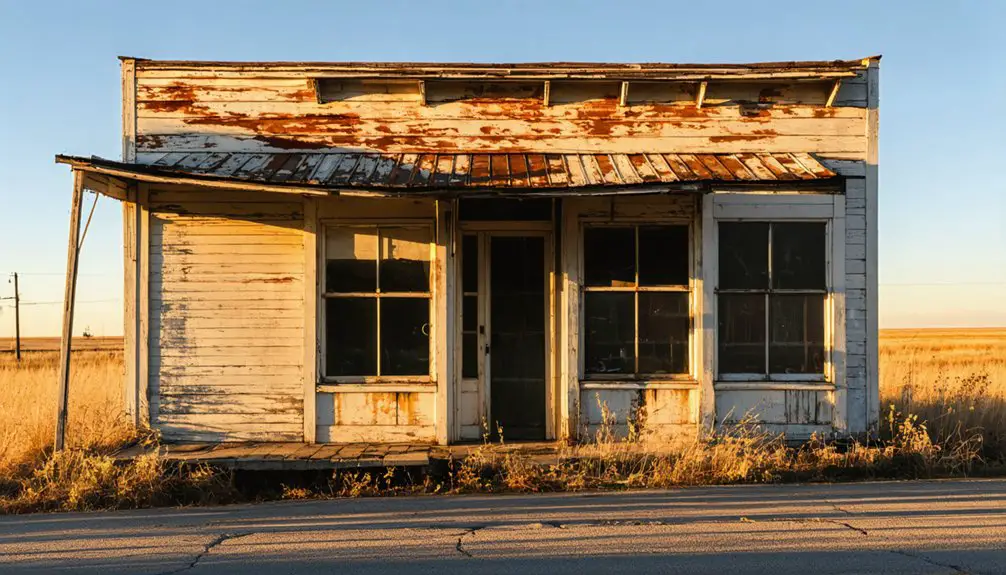You’ll find Midian’s ghostly remains in Kansas, where this once-bustling oil boomtown flourished in the early 1900s. The settlement’s unique blend of biblical heritage and Masonic influence shaped its identity, with oil workers and their families creating a tight-knit community around the drilling operations. Though the town vanished after the 1940s oil decline, its wrought iron cemetery arch stood as a silent sentinel until 1995. Midian’s story weaves together frontier dreams, sacred symbols, and industrial ambition.
Key Takeaways
- Midian transformed from a thriving oil boom town to a ghost town after oil production declined in the 1940s.
- The town’s last physical monument, a wrought iron cemetery arch, stood until 1995 before being removed due to deterioration.
- During its peak, Midian produced 29 million barrels of oil annually and featured company housing, pipe yards, and lumber facilities.
- The community was shaped by both oil industry workers and Masonic influence, with the Midian Shrine established in 1909.
- Only historical records, aging photographs, and digital narratives preserve Midian’s memory as a once-prosperous Kansas oil town.
The Origins of Midian’s Mysterious Name
While many Kansas ghost towns bear straightforward names reflecting their founders or geographic features, Midian’s name draws from a rich tapestry of biblical and mystical origins.
Unlike typical Kansas town names, Midian’s identity emerges from an intriguing fusion of biblical history and mystical symbolism.
You’ll find its roots in the biblical figure of Midian, the fourth son of Abraham, who founded an ancient kingdom that became home to nomadic desert peoples.
The name carries dual significance through its connection to the Masonic Order of the Midian Shrine, which added layers of mystical significance to the town’s identity.
This unique blend of biblical connection and masonic heritage sets Midian apart from typical frontier settlements. Like the town of Columbia which faced violent attacks in 1856, Midian’s early history was marked by conflict and uncertainty.
Much like Mount Casino, which was established by three Benedictine priests seeking to build a monastery, Midian held deep religious significance for its early settlers.
Local legends even speak of a Midianite shrine near the town site, said to possess supernatural powers, further cementing the town’s reputation as a place where the physical and spiritual domains intersect.
Life in a Kansas Oil Boomtown
If you’d lived in Midian during the oil boom, you’d have found yourself working alongside neighbors in the endless cycle of drilling, with rigs running day and night while supporting businesses adapted to serve the round-the-clock workforce.
You’d have seen the town transform as thousands of workers and their families poured in, with oil companies like Cities Service building everything from homes to recreation halls to create a complete community. Essential services like pipe and lumber yards supported the bustling drilling operations. The booming field reached its peak during World War I, when 29 million barrels of oil flowed annually.
The good times wouldn’t last forever though, as declining oil production by the 1940s meant fewer jobs, leading many of your fellow workers to pack up and move on as Midian began its shift to ghost town status.
Oil Workers Daily Life
As dawn broke over Midian’s oil fields, workers poured into the densely packed industrial landscape for their daily “tours” of drilling, pipe handling, and machinery maintenance.
You’d find yourself among a tight-knit community where oil drilling dominated every aspect of life, and worker camaraderie formed the backbone of daily existence.
Living in Midian meant adapting to the rhythms of a 24-hour boomtown. Here’s what your typical day might include:
- Working shoulder-to-shoulder with fellow crew members in physically demanding shifts
- Grabbing meals at always-open cafes between tours
- Spending off-hours at the welfare hall with other company families
- Returning home to modest company housing within earshot of the drilling rigs
The demands were tough, but the sense of shared purpose and community made the hardships worthwhile. The booming oil industry brought unprecedented prosperity, with Butler County’s population nearly doubling to 43,000 by 1920.
Boom to Bust Economy
The discovery of oil near El Dorado in 1915 transformed sleepy Kansas prairies into bustling boomtowns like Midian, where you’d witness fortunes rise as fast as drilling derricks.
By 1918, you could find yourself among thousands of workers as the region pumped out 29 million barrels annually, nearly a tenth of America’s oil production.
Life revolved around the oil companies that built your town. They’d provide your housing, your job, and even your entertainment. Local shops, from lumber yards to barber shops, thrived on your business.
But you couldn’t escape the boom-to-bust reality of oil towns. When production declined in the 1940s, the economic downturn hit hard.
The Masonic Connection and Biblical Roots
Masonic influence runs deep through Midian’s historical roots, intertwining biblical symbolism with fraternal traditions that shaped the community’s identity. The town’s name itself draws from the ancient biblical land where Moses found refuge, reflecting the Masonic practice of incorporating spiritual allegories into community foundations. York Rite bodies like Council No. 1 helped establish the strong Masonic presence in the region.
You’ll find these Masonic connections evident through:
- The Grand Lodge of Kansas’s establishment in 1856, which laid groundwork for Midian’s fraternal framework.
- The Midian Shrine’s 1909 founding in nearby Wichita, extending Masonic influence.
- Integration of Middle Eastern themes and biblical symbolism in local ceremonies.
- Strong ties between Masonic lodges and civic leadership, which influenced town development.
These fraternal bonds created lasting networks of influence that shaped Midian’s social fabric during its brief but significant existence. During the 1920s, local Masonic lodges demonstrated their principles through active opposition to KKK recruitment efforts targeting their organization.
From Bustling Streets to Empty Fields
Once a thriving frontier settlement bustling with miners, merchants, and Masonic brotherhood, Midian’s transformation into empty Kansas fields tells a poignant story of boom-and-bust economics in America’s heartland.
Similar to Empire City, which saw its population plummet after its lead deposits vanished, Midian faced the harsh realities of dependence on natural resources.
You’ll find that like many Kansas ghost towns, Midian’s decline stemmed from its heavy reliance on a single industry and lack of economic sustainability. When market forces shifted and transportation routes changed, the town couldn’t adapt. The arrival of higher-quality coal via railroads severely impacted local mining operations.
Today, as you walk through what remains, you’ll notice how nature has reclaimed the once-busy streets where your ancestors might’ve worked and lived.
While some communities have achieved ghost town revival through tourism and preservation efforts, Midian stands as a reflection of the challenging realities faced by resource-dependent towns in the Midwest’s ever-changing landscape.
Folklore and Digital Legacy

While physical traces of Midian have vanished into Kansas soil, a rich tapestry of folklore and digital presence keeps the town’s spirit alive.
The town’s mystical heritage, rooted in biblical origins and Masonic connections, has evolved into compelling digital folklore that captures imaginations across generations.
Like Pitcher, Oklahoma, once a thriving mining community that dissolved into a ghost town, Midian serves as a stark reminder of how quickly bustling settlements can fade away.
You’ll discover these fascinating elements of Midian’s enduring legacy:
- Ancient Midianite shrine legends tell of supernatural powers hidden beneath a local farmhouse.
- Digital ghost narratives portray the town as a metaphysical gateway between worlds.
- Role-playing games and online communities preserve the town’s memory through interactive storytelling.
- Search engine quirks have transformed Midian into a true “ghost in the machine,” existing primarily in cyberspace.
These digital footprints and supernatural tales guarantee Midian’s story continues to intrigue history enthusiasts and folklore collectors alike.
The Last Traces: Midian Cemetery Arch
You’ll find that Midian’s wrought iron cemetery arch stood as the town’s last visible monument until 1995, marking both the physical gateway to the relocated cemetery and a symbolic portal to the community’s oil boom past.
If you’d traced your family roots to this Butler County ghost town before Highway 254’s construction, you’d have recognized this sturdy iron landmark as a reflection of the craftsmanship of early Kansas settlers.
Your search for tangible connections to Midian’s history became considerably harder after road development claimed this final architectural remnant, leaving the site’s legacy to exist primarily in records and memory.
Historical Gateway Symbol
As a tribute to Midian’s fleeting existence, the wrought iron arch that once marked the entrance to the town’s cemetery stood as the last physical remnant of this Kansas oil boomtown until the mid-1990s.
The gateway’s historical significance extended beyond its practical purpose, representing the spirit of a once-thriving community.
You’ll find the arch’s symbolic representation captured in these defining characteristics:
- Served as the final tangible connection to Midian’s oil boom heritage
- Marked the sacred ground where early settlers and townspeople were laid to rest
- Reflected the craftsmanship and architectural style of the early 1900s
- Stood as a silent witness to the town’s evolution from prosperity to abandonment
Today, like the town itself, the arch exists only in historical records and memories.
Iron Landmark’s Final Days
Before its ultimate removal in the late 20th century, the Midian Cemetery arch endured decades of unrelenting exposure to Kansas weather and neglect.
You’d have witnessed the iron landmark’s gradual arch deterioration, as rust and corrosion weakened its once-proud frame that had welcomed generations of visitors for community rituals and cemetery visitations.
The structure’s decline marked more than just physical decay – it represented the fading presence of Midian’s ghost town heritage.
While photographs from mid-century archives captured its various states of disrepair, no preservation efforts emerged to save this architectural landmark.
Safety concerns from the weakened iron ultimately led to its removal, though you won’t find definitive records of its final fate.
Today, only historical guides and aging photographs preserve the memory of this significant gateway.
Frequently Asked Questions
How Many People Lived in Midian During Its Peak Population?
You’ll find that Midian’s demographics peaked between 600-1,000 residents during its mining heyday, with Midian history records showing bustling activity from multiple businesses, churches, and social establishments supporting this population.
Were There Any Documented Accidents or Deaths in Midian’s Oil Fields?
You won’t find documented oil field safety incidents specific to Midian in public records, though Kansas historical accidents show similar oilfields experienced explosions, fires, and equipment-related deaths during this era.
What Happened to the Records and Documents From Midian’s Town Offices?
You’ll find most town archives were lost when Midian declined, as there wasn’t any formal historical preservation system. Records likely deteriorated, were scattered, or destroyed due to abandonment and environmental exposure.
Did Any Original Midian Buildings Survive and Get Relocated Elsewhere?
Like whispers in the prairie wind, you won’t find any relocated Midian buildings today. Despite regional interest in historic preservation, there’s no evidence that building relocation efforts saved any original structures.
What Specific Oil Companies Operated Wells in the Midian Area?
Cities Service dominated the oil exploration in your area, while Standard Oil, Empire Oil, Gypsy Oil, and Carter Oil also ran drilling operations there, using various drilling techniques across the local fields.
References
- http://arcana.wikidot.com/midian-kansas
- https://www.hhhistory.com/2019/05/ghost-towns-of-kansas.html
- https://www.youtube.com/watch?v=alC1wDdSVvg
- https://legendsofkansas.com/kansas-ghost-town-list/
- https://www.youtube.com/watch?v=OyBXD18P_j4
- https://dianastaresinicdeane.wordpress.com/2012/01/29/columbia-a-kansas-ghost-town-story/
- https://www.youtube.com/watch?v=gkfXLg-ftys
- https://octa-trails.org/archaeology/uniontown-and-plowboy-potawatomi-ghost-towns-enigmas-of-the-oregon-california-trail/
- https://esirc.emporia.edu/bitstream/handle/123456789/1313/Richards Vol 5 Num 1.pdf?sequence=4
- https://www.hmdb.org/m.asp?m=56168



